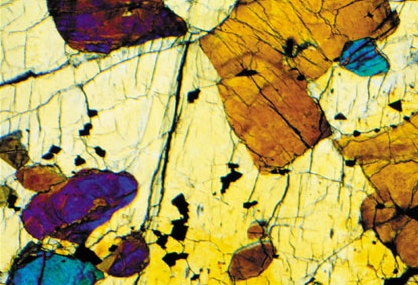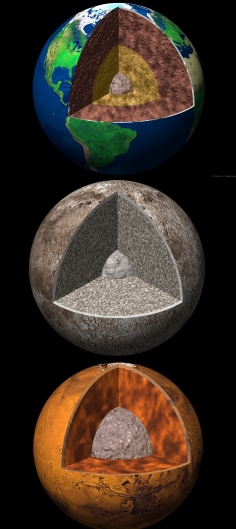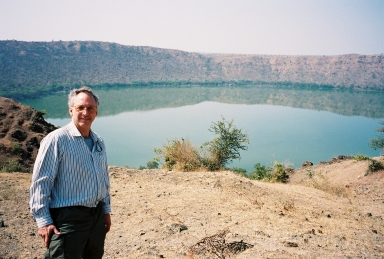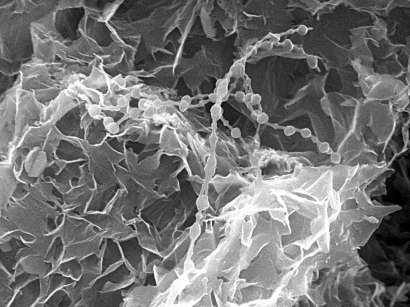IOM Research

Microbeam Studies of Planetary Materials
Funded by: NASA Cosmochemistry Program
Lead Investigator/s: Papike, Shearer, Burger
These studies emphasize the study of planetary samples from asteroids (meteorites), Mars (meteorites), and the Moon (NASA Apollo samples, Russian Luna samples, meteorites). Our techniques, referred to as microbeam (electron microprobe, SEM, SIMS, TEM), enable us to measure concentrations of major, minor, and trace elements, and stable isotope ratios with high spatial resolution (small analytical volume). This capability is very important because many of the minerals in planetary samples are very small. These data give us new insights into a range of fundamental questions about our Solar System from its earliest origin to the evolution of planetary bodies. Recent efforts in this area have extended beyond these now-traditional techniques by employing synchrotron-based techniques such as XANES to measure valence states of multivalent elements such as Cr and V. These measurements have provided insights into the comparative oxidation states in terrestrial planetary interiors.

Experimental Studies of Planetary Magmas at High Pressure
Funded by: NASA Cosmochemistry Program, National Science Foundation Earth Sciences Directorate
Lead Investigator/s: Agee
This program makes use of high pressure and high temperature experimental apparatus. High pressure equipment consists of 2 solid media devices, a multi-anvil press designed to reach pressures between about 3 and 25 GPa (1 GPa = about ten thousand atmospheres pressure) and a piston-cylinder press designed to achieve pressures of 0.5 to 2.5 GPa. The high temperature furnace can reach approximately 1600ºC under a range of pertinent oxygen fugacities. We use this equipment to perform experiments on geological and planetary materials at the elevated pressures and temperatures appropriate to their formation. The goal of our experiments is to mimic the conditions inside planetary bodies (mainly Earth, the Moon, and Mars) where processes took place that gave rise to igneous rocks. Armed with this type of information, models can be constructed that help explain how terrestrial planets form, in general, and how particular magmatic processes control various compositional relationships in these rock types. Work in the Experimental Petrology group currently focuses on the following topics: differentiation of the martian mantle; deep-seated magmatism on the Moon; systematics of crystal-chemical controls on garnet-melt trace element partitioning in any terrestrial interior; the effects of water and carbon dioxide on the generation of primitive martian parent liquids; the role of volatiles in affecting silicate melt density; and processes of terrestrial-planet core formation. Our martian work has three major tasks. 1) Experiments designed to constrain the nature and composition of the martian mantle by mapping the effect of Fe contents on near-solidus phase relations of putative mantle protoliths. 2) Experiments aimed at elucidating processes taking place in a possible early Mars magma ocean. 3) Determine the role of dissolved volatiles in the generation of the most primitive martian basalts. Results from all these studies advance our understanding of the early differentiation of the martian mantle and on the origins of the martian meteorites. Our lunar work largely involves phase-equilibrium and element-partitioning studies of lunar picritic glasses to determine whether garnet was present in their source regions, which would constrain the composition and physical state of the deep lunar interior. In addition, an ambitious program will be underway soon to test experimentally the widely-held magma-ocean model for formation of the Moon following a giant impact between the proto-Earth and a roughly Mars-sized body very early in the history of the solar system. Experiments expanding on the garnet work mentioned above to generalize crystal-chemical controls on garnet-melt element partitioning has made use of these lunar compositions, as well as terrestrial ones. In addition, work on the partitioning of elements between possible core-forming metal melts and coexisting silicate melts is underway.

Martian impact crater hydrothermal systems: Clues from the Lonar (India) crater
Funded by: NASA Planetary Geology and Geophysics Program
Lead Investigator/s: Newsom
This project continues our strong research efforts into hydrothermal processes in impact craters on Mars, as possible environments to search for evidence of biotic or pre-biotic chemistry, and to understand the role of impacts in near-surface chemical transport and soil formation. Because the craters on Mars are most likely to have formed in basaltic terrains, we are studying the deposits at the Lonar Crater, India. Our most important result so far is the evidence for impact induced hydrothermal processes in the samples from the Lonar crater. We are continuing our work on samples from the Lonar crater as well as extending our work to other craters on the Earth including Mistastin and Chicxulub, because of the much larger size of the heat sources and the potential for longer-lived hydrothermal systems that resulted in greater mobile element transport. We also contributed to the study of the landing sites for the 2003 Mars Exploration Rovers.

Identification of Microbial Signatures in Biogenic Cave Ferromanganese Deposits
Funded by: ational Science Foundation, Biogeosciences Directorate
Lead Investigator/s: Spilde
The subsurface environment of Mars is of particular interest in the search for evidence of life because it provides a safe, stable environment where water may be present. Various subsurface environments, such as caves and lava tubes, on Earth can provide analogies to the subsurface of Mars. This research involves the study of chemolithoautrophic microorganisms, organisms that derive all their energy by breaking down rock as an energy source. These organisms are present in some terrestrial caves where they produce deposits of iron and manganese oxides on cave walls. We are studying microbial manganese deposits in Lechuguilla Cave, in lava tubes and in desert varnish in New Mexico to understand the processes by which these minerals are formed. By identifying and understanding such organisms on Earth, we may gain insight into how life could survive in the subsurface of Mars.

Participation in Robotic Exploration Missions
Funded by: NASA
Lead Investigator/s: Newsom
We are participating in several robotic missions that are or will explore planetary bodies. The gamma rays that escape from planetary surfaces and detected in orbit are studied to determine the abundances of Fe, Si, K, Th, and other elements in the top meter of the planet’s surface. The gamma rays are made by the decay of naturally-occurring radioelements (K, U, and Th) or by cosmic-ray interactions (mainly neutron-capture or inelastic-scattering reactions), see the figure. We are studying Mars using gamma rays measured by the 2001 Mars Odyssey, and plans are being made to study the Moon using gamma rays measured by the Japanese SELENE spacecraft (scheduled to be launched in late 2007). We are also participating in the Mars Exploration Rover science team and the upcoming Mars Science Laboratory (scheduled 2009 launch) mission.
